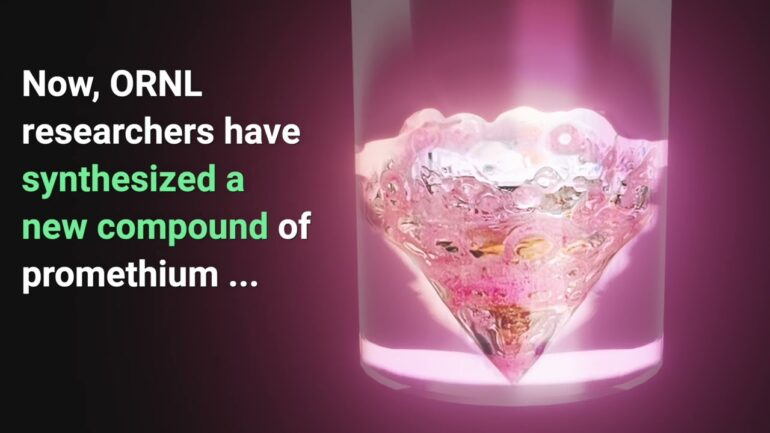When element 61, also known as promethium, was first isolated by scientists at the Department of Energy’s Oak Ridge National Laboratory in 1945, it completed the series of chemical elements known as lanthanides. However, aspects of the element’s exact chemical nature have remained a mystery until last year, when a team of scientists from ORNL and the National Institute of Standards and Technology used a combination of experimentation and computer simulation to purify the promethium radionuclide and synthesize a coordination complex that was characterized for the first time. The results of their work were recently published in Nature.
Promethium is one of 15 lanthanides, also known as rare earth elements. Despite being called “rare,” many of these elements are extensively used in modern technology, including electric motors, spacecraft batteries and radiation therapy, as well as smart phones and computer monitors.
Though scientists have known about promethium for nearly 80 years, it was the only remaining lanthanide to be characterized in the bound form—essential for identifying an element’s electronic structure and properties. This was because radioactive promethium is particularly elusive in nature due to its short half-life (the time it takes for one half of the nuclei in a given amount of a radioactive element to decay) of only 2.5 years.
“This is fundamental research,” said Dmytro Bykov, a theoretical chemist and group leader for Advanced Computing for Chemistry and Materials at ORNL who co-led the computational spectroscopy simulation of the promethium complex with Santanu Roy, also of ORNL. “Since the discovery of the periodic law, we have had a good understanding of all the elements, but that doesn’t change the fact that you need to experiment to confirm that understanding. It was nice to find this final puzzle piece.”
The experimental investigation of promethium included developing a novel, water-soluble complexing agent and using X-ray absorption spectroscopy to determine the electronic structure of the element. However, there are pieces of the picture that experimentation can’t easily show, so it was combined with theoretical and computational chemistry to paint a fuller image of promethium.
The team modeled the element using the IBM AC922 supercomputer Summit, located at the Oak Ridge Leadership Computing Facility at ORNL. They were awarded time on the supercomputer through the Director’s Discretionary Program. The OLCF is a Department of Energy Office of Science user facility.
“This is experimental science, so the most important thing is that the team purified and characterized the element in the bound form. But the cherry on top is that we were able to run these simulations for a deeper understanding of the experimental observations,” Bykov said.
Simulating promethium’s electronic structure presented its own challenges and required solving complex equations to model the element’s electrons. The simplified visualization of atomic structure seen in most textbooks shows a nucleus of protons and neutrons orbited by electrons on fixed paths. In reality, electrons are quantum objects whose behavior is more similar to a wave, and their exact position at any given moment is a matter of probability. The key to simulating promethium’s structure was solving the Schrödinger equation.
Solving the equation describes the wavefunctions and energies of electrons in an atom or molecule in the same way a simple wave equation describes the vibration of a plucked guitar string. Scientists then use this information and observations from spectroscopy to represent the atom or molecule in 3D. The simulations of the element build a more comprehensive picture than can be created with an or the experiment alone.
“Most of the time in an experiment, you can’t measure everything. You have a specific set of conditions, and the experiment is a snapshot. In the computer, we can change the conditions and get a deeper understanding of the element’s properties,” Bykov said.
“We all stand on the shoulders of giants,” Bykov continued. “A lot of knowledge we had already, and there was so much work done at this lab. Summit, this marvelous machine, was built by very smart engineers and technicians. And it all came together to characterize and fully understand this remarkable compound of this very rare element for the first time.”
More information:
Darren M. Driscoll et al, Observation of a promethium complex in solution, Nature (2024). DOI: 10.1038/s41586-024-07267-6
Provided by
Oak Ridge National Laboratory
Citation:
Quantum chemistry and simulation help characterize coordination complex of elusive element 61 (2024, June 7)



